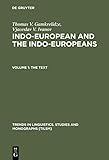Indo-European and the Indo-Europeans : A Reconstruction and Historical Analysis of a Proto-Language and Proto-Culture. Part I: The Text. Part II: Bibliography, Indexes / Thomas V. Gamkrelidze, Vjaceslav V. Ivanov.
Material type: TextSeries: Trends in Linguistics. Studies and Monographs [TiLSM] ; 80Publisher: Berlin ; Boston : De Gruyter Mouton, [2010]Copyright date: ©1995Edition: Reprint 2010Description: 1 online resourceContent type:
TextSeries: Trends in Linguistics. Studies and Monographs [TiLSM] ; 80Publisher: Berlin ; Boston : De Gruyter Mouton, [2010]Copyright date: ©1995Edition: Reprint 2010Description: 1 online resourceContent type: - 9783110147285
- 9783110815030
- 415 20
- P572 .G3613 1995
- online - DeGruyter
- Issued also in print.
| Item type | Current library | Call number | URL | Status | Notes | Barcode | |
|---|---|---|---|---|---|---|---|
 eBook
eBook
|
Biblioteca "Angelicum" Pont. Univ. S.Tommaso d'Aquino Nuvola online | online - DeGruyter (Browse shelf(Opens below)) | Online access | Not for loan (Accesso limitato) | Accesso per gli utenti autorizzati / Access for authorized users | (dgr)9783110815030 |
Browsing Biblioteca "Angelicum" Pont. Univ. S.Tommaso d'Aquino shelves, Shelving location: Nuvola online Close shelf browser (Hides shelf browser)
Part I: The Text. -- I-CVI -- Section One: The Phonological System and Morphophonology of Proto-Indo-European -- Chapter One — The three Indo-European stop series: Paradigmatics and syntagmatics -- Chapter Two — The Indo-European points of stop articulation and the Indo-European sibilants: Paradigmatics and syntagmatics -- Chapter Three — The vowel system and the theory of morphophonological alternations. Sonants and laryngeals in Indo-European -- Chapter Four — The structure of the Indo-European root -- Section Two: The Grammatical Structure of Proto-Indo-European -- Chapter Five — Proto-Indo-European as a language of the active type -- Chapter Six — The grammatical syntagmatics of Proto-Indo-European in typological perspective -- Section Three: The Areal Organization of Proto-Indo-European -- Chapter Seven — The differentiation of the Indo-European linguistic region -- Part II: Bibliography, Indexes -- I-XXXIV -- Bibliography -- Indexes -- Languages and Dialects. Indo-European Languages -- Proto-Indo-European Roots, Stems, and Affixes -- Non-Indo-European Languages -- Onomastic Indexes -- Species -- Sources
restricted access online access with authorization star
http://purl.org/coar/access_right/c_16ec
“Gamkrelidze and Ivanov’s wide-ranging and interdisciplinary work, superbly translated from Russian, is a must for every student of Indo-European prehistory. Its erudition is unsurpassed, and its unorthodox conclusions are a continuing challenge.” Prof. Dr. Martin Haspelmath, Max-Planck-Institut für Evolutionäre Anthropologie
“Gamkrelidze and Ivanov’s wide-ranging and interdisciplinary work, superbly translated from Russian, is a must for every student of Indo-European prehistory. Its erudition is unsurpassed, and its unorthodox conclusions are a continuing challenge.” Prof. Dr. Martin Haspelmath, Max-Planck-Institut für Evolutionäre Anthropologie The authors propose a revision of views on a number of central issues of Indo-European studies. Based on findings of typology, they suggest a new analysis of the phonological system of Proto-Indo-European (the ‘Glottalic Theory’); they offer novel assumptions about the relative chronology of changes in PIE vowels and laryngeals. Their conclusions are compared with data from Proto-Kartvelian. In the second part of the book, semantically organized presentation of material from the lexicon is combined with analyses of the use of forms and formulae in a broadly defined cultural context. Again similarities with properties of primarily Kartvelian and Semitic are described , and extended close contacts with these language families are postulated. This necessarily leads to a proposal to place the hypothetical Urheimat of the Indo-Europeans in the region south of the Caucasus. Volume and II of the original Russian edition have been combined in the English version as Part I; the Bibliography and Indexes are published as Part II.
Issued also in print.
Mode of access: Internet via World Wide Web.
In English.
Description based on online resource; title from PDF title page (publisher's Web site, viewed 28. Feb 2023)









